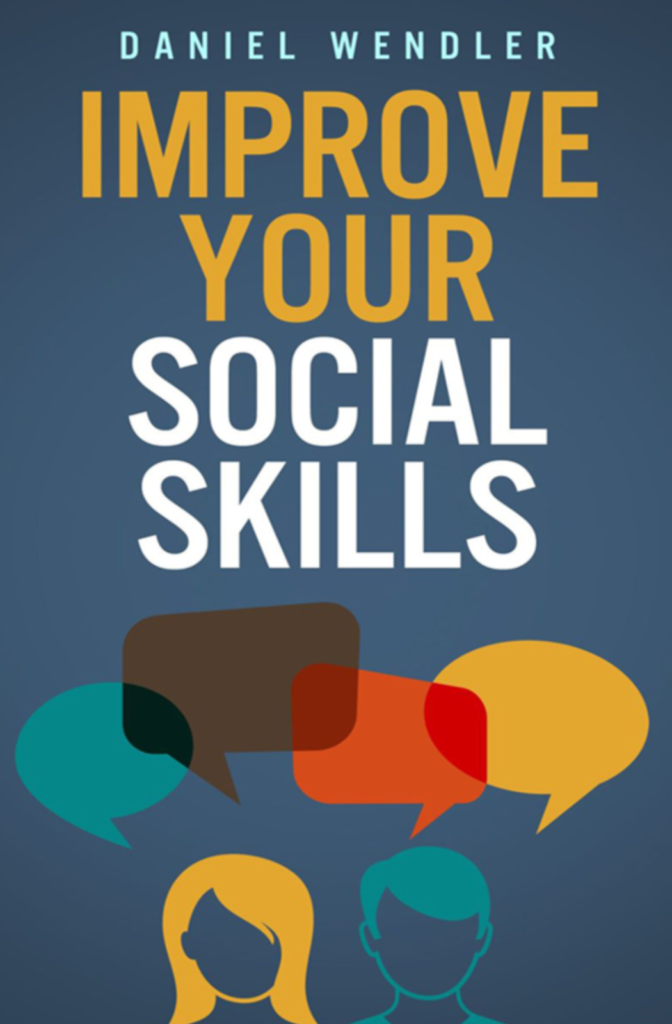
Improve your social skills is a comprehensive and practical guide that will help you make your social skills better, the book was published on September 12th, 2014. The writer explains the principles that will guide you in improving your social life. These principles create awareness on how you can get better friendships, improve your dating life and learn how to communicate with others through the use of body language.
HOW THIS BOOK HELPED US?
The book helped us make better friendships by identifying people with mutual understanding and also build better and healthier relationships with our partners by focusing more on giving to each other rather than receiving from each other.
THE BOOK EXPLAINED IN UNDER 60 SECONDS
- The book explains that not only verbal communication but also body language is crucial during communication and shows you how you can read and understand other people’s body language.
- Guidelines on how to make better friendships like spotting for people who have the same interests as you are clearly laid out.
- The writer talks about how understanding yourself first will be of great importance in empathizing with others.
TOP THREE QUOTES
- “You will never get the true intimacy you’re seeking with deceit.”
- “When you want to inspire your partner, be deliberate to share something that might inspire them to share their curiosity, their thoughts, or their story.”
- “Most serious problems are not solved in a single conversation, and you may need to support your friends over weeks or even months.”
BOOK SUMMARY AND NOTES
CHAPTER ONE: THE FOUNDATIONS

- Setting goals for your social skills journey.
Before you start improving your social skills, you need to set goals for what you want to achieve. Setting goals helps you identify where you are (current position) and where you are going (future). Where you are is associated with you realizing your current social strengths and weaknesses and what impact they put on your life. Identify the practical areas of your social skills you want to improve and create a concrete strategy that will help you improve your social interaction.
- Overcoming fear and social anxiety.
Overcoming fear is a process where you have to embrace small but steady steps away from fear. Luckily, there is a way to overcome your fear and keep it from controlling you. Differentiate between true fear and physical fear. True fear is a warning your body signals when you’re in danger while physical fear is the fear response the body signals even when you’re not in danger. Your fear for social interactions is just physical fear and it can not hurt you.
- Manipulation Vs. True intimacy
True fulfilling relationships are always established on mutual trust and respect. If you manipulate people, consider yourself disrespecting the relationship you have with them. This will damage the trust people have in you as soon as they find out. The true intimacy you’re seeking will not be achieved through deceit and manipulation but rather through letting people know you the way you are.
Favourite quote of the chapter: “You will never get the true intimacy you’re seeking with deceit.”
CHAPTER TWO: BODY LANGUAGE

- Comfort and Discomfort:
Communication involves a nonverbal function mostly known as body language. Our bodies send us various body language signals but the most important ones are the comfort and discomfort signals. The comfort signal will let you know that the person is feeling good and the discomfort signal will imply that the person is having something that is bothering them. These clues will tell you how someone feels and you will know exactly how to respond.
- A field guide to comfort:
People will show comfort in various ways when they’re interested in the conversation you’re telling such as; leaning in or moving closer. When someone is interested in what you’re saying, they will eliminate the distance between the two of you.
- A field guide to discomfort:
People tend to show discomfort when listening to conversations they’re not interested in. When you pick up discomfort signals like touching their neck, identify the cause of the discomfort and try as much as you can to eliminate it. Once your partner starts giving off comfort signals, then you have succeeded.
- Your body language:
Your partner may not consciously examine your body language but they’ll instead react to it and will interpret it according to how you feel. Many people don’t think about what their body language signals to them. They spend a lot of time thinking of the right words to say, without taking time to reflect on what their body language tells them. Therefore their words and body language will broadcast very different messages. That can be avoided by becoming conscious of the messages your body is sending.
Favourite quote of the chapter: “When your body language is cold and standoffish, people are unlikely to approach you, even if you want them to.”
CHAPTER THREE: CONVERSATION

- The secret of conversation flow.
A conversation flow must feel fluent, comfortable and tends to happen automatically. When conversations do not flow, simply apply the principles of invitation and inspiration. An invitation is when you say something that lets your partner know that it’s their turn to speak while also providing suggestions of what to speak about. An inspiration induces your partner to share the curiosity and thoughts of their story willingly.
- Invitation.
Here the goal is to keep the conversation flowing. One of the main tools you need to keep a conversation flowing is the idea of invitation. An invitation will convey very clearly that it’s now your partner’s turn to talk and offer suggestions for what your partner should talk about. It should relate to the subject that is being discussed by both of you.
- Inspiration.
When you inspire your partner to share a story, the conversation flows smoothly and makes you feel closer one to one another. You can inspire your partner when you share something that will make them want to share something with you in return, inspiration does not make your partner feel compelled to share but rather It makes them want to share.
Favourite quote of the chapter: “When you want to inspire your partner, be deliberate to share something that might inspire them to share their curiosity, their thoughts, or their story.”
CHAPTER FOUR: GROUP CONVERSATION

- Open and Closed Groups
Groups are put into two classes; open groups and closed groups. Open groups will not mind new people joining them as they will freely flow in and out of the group. To identify an open group, simply look at its body language signals such as facing the crowd, excited and welcoming. Closed groups are not exposed to newcomers but that doesn’t mean that they are not friendly. Pulling away from the crowd and members facing each face other when sharing stories are some of the body language signals that closed groups send-off.
- Joining Group Conversations
Your main aim here is to become a member of the group. Use the direct approach and the indirect approach to join conversational groups. The direct approach will require you to walk straight to the group, introduce yourself and immediately back your introduction with a follow-up question. With the indirect approach, you join the group based on its existing discussion or if the group includes someone you know.
Favourite quote of the chapter: “Most social interactions take place in a group setting, and navigating the waters of group conversation can be much trickier than one-on-one conversations.”
CHAPTER FIVE: EMPATHY

- Understanding yourself.
Empathizing with yourself is essential in social interactions. Self-empathy means understanding and accepting what you’re feeling and why you’re feeling that way. Understand the cause of your emotions, permit yourself to feel an emotion and have a suitable way to express those emotions. After understanding your emotions, accept them and try to improve your situation by either seeking a counsellor’s help or permitting yourself to experience the feelings you have.
- Understanding others.
Understanding others at times requires more than just self-empathy. You have to spend time thinking about the way other people understand the world. When having a conversation with a friend, don’t see the situation from your perspective. Chances are that you’ll get bored with the conversation your friend is telling. Take the time to look at the situation from the friend’s perspective, you’ll get to know how they feel and understand their actions. Establishing empathy is not easy, but as you continue to view the situation from the other person’s perspective, you start acquiring true empathy for others.
- Nonverbal empathy
There is a nonverbal element that reacts to empathy, your words and your nonverbal signals have to work together for you to deliver a good social interaction. If your friend is sad and you ask them “what’s wrong?” in an exciting way, they will think you don’t care about their situation. However, when you pause and ask the question in a sympathetic and concerned way, chances are that your friend is likely to believe you want to hear what’s wrong. So make sure your verbal and nonverbal signals correspond.
Favourite quote of the chapter: “When you have empathy, it means you can understand what a person is feeling in a given moment and understand why other people’s actions made sense to them.”
CHAPTER SIX: MEETING PEOPLE

- Finding your group
Social groups are never equal and if you join one where you don’t fit in, it will be hard for you to make friends. Many people join groups and find themselves stuck around boring people because they joined the wrong group. Find a group where you have something in common. This will give you a better chance of making friends.
- Everyday connections
Social groups are not the only way of meeting new people. A relationship can set off anytime two people meet and interact. However, people who interact daily have high chances of becoming friends if they interact on a person-to-person level. Connecting on a person-to-person level will alert the other person that you’re interested in knowing them and will create an opportunity for both of you to connect.
- Person to Person connections
Person-to-person connections allow a real connection to take place between two people. Connecting on a person-to-person level makes the other person realize how interested you are in knowing them. Bear in mind this simple principle while practising person-to-person connections. Some people are not open to connecting, therefore you must recognize when others would rather not connect and respect their wishes to avoid irritating them.
Favourite quote of the chapter: “The responsibility for meeting people and creating a connection with them falls squarely in your lap.”
CHAPTER SEVEN: MAKING FRIENDS

- Find good friends
When making friends, identify people who will be good friends to you. A good friend will care about you, enjoy spending time with you and accept you for who you are and you won’t have to pretend when around them. You can identify people who will be good friends to you in the future by looking at the way they treat you today. Ask yourself this simple question, does this person like spending time with me? If they don’t, they won’t be a good friend for you.
- Starting a friendship
Once you get to know the right person to be friends with, embark on starting the friendship by making the first move. The first move is pretty simple, invite the person and spend some time with them outside the normal environment that you see them in. For example, if it’s at church, then invite the person for a football game. Make sure you choose an activity that the person will enjoy and will give you room to talk and get to know each other.
Favourite quote of the chapter: “Friendly folks are not the same as folks who are your friends.”
CHAPTER EIGHT: HOW TO SUPPORT YOUR FRIENDS

- Supporting your friends at the moment
Be present. You have a friend who is going through a hard time, your job is to be there with them. Give them room to express their feelings, talk about themselves if they want. Guarantee that even though you can’t fix their problems, they don’t have to face them alone. Remember it’s not your duty to advise although a little advice might be helpful.
It’s not about you. When someone shares their problem with you, it’s good to share a similar experience from your own life. It helps in empathizing and encouraging them to stay strong. Don’t share your experience to put yourself in the spotlight but rather to help a friend.
Make specific, tangible offers. It’s not ideal to say “let me know if you need anything” though it can be a good start. Provide a tangible offer like would you like to hang out later or should we get something to eat. When making your specific offers, be careful not to fix the other person’s problem or make it insignificant.
- Supporting a friend long term
Follow up. Big problems don’t go away in a blink of an eye. If you have a friend who is battling a significant problem, endeavour to check in with them to know how they are holding up. People often draw back from social interaction when they’re depressed, therefore reach out to them in case you have not seen them in a while.
Don’t insist. At times, the best thing to do is to back off and give your friend some space. They may not want to talk about their problems because they feel like they’re not close enough to open up or maybe they’re already getting significant support from someone else. Therefore insisting may make their situation worse for them
Favourite quote of the chapter: “Most serious problems are not solved in a single conversation, and you may need to support your friends over weeks or even months.”
CHAPTER NINE: DATING

- Healthy relationship defined
A healthy relationship is one where both partners accept and cherish each other. Encourage each other to grow and focus on giving rather than receiving from each other. If you want a healthy relationship, put in the work. It will require you to dedicate yourself to your partner’s well-being and happiness. Swallow your pride, selfishness and possess the willingness to make short-term sacrifices that will bring lasting joy. Your hard commitment will be required for it to work.
- How to have a healthy relationship
Relationships are different but there are core principles you can base on to build a healthy relationship regardless of its nature. Freedom and acceptance are essential, feel free around your partner and accept each other for who you really are. Never hide part of yourself from your partner to be accepted but this does not mean that your partner has to approve everything you do.
- Building a relationship worth having
Building a worthy relationship takes time. If you’re not willing to give it that time, chances are that you will have an unhealthy relationship. It takes time to build true intimacy and trust. Just like it will take time for two people to learn how to love each other truly. Therefore, invest time and patience in your relationship and you’ll have astonishing results.
Favourite quote of the chapter: “Dating can be wonderful. Having a special someone to share your experiences with makes life sweeter and having someone who knows you deeply can help you understand yourself better too.”
CHAPTER TEN: HOW TO BE A GOOD STORYTELLER

- Hold their interest
Start with a hook. Holding the interest of your audience will require you to grab their attention first. Begin with a hook, a hook is a statement that takes hold of your audience’s attention and also provides clues to them of what is coming up in the story. A hook will help your audience understand what your story is about before it begins.
Have a point. Before you tell a story, ask yourself what’s the goal of the story. For your story not to bore the audience, make sure you have packed with only the details that support the goal of the story.
- Build a connection
Tell personal stories, but cautiously. Telling personal stories about your life will create a great opportunity to connect with others. Sharing stories concerning important aspects of your life allows your audience to learn something new about you which establishes a connection. Be careful about how much you share with your audience, a connection is built over time. Don’t jump right to a very internal story before a connection is established otherwise your audience will get uncomfortable.
Share first-hand thoughts and feelings. When telling a story about a certain aspect of your life, don’t just state the facts. Talk about how you felt and what you were thinking at the moment. Don’t limit your story to facts that an outside observer would notice. Give your audience a glance at what was in your head by sharing your thoughts and feelings. This will help your audience to experience the story as you did while enhancing and building a connection.
- A satisfying conclusion
Once your story has reached the climax, try to bring it to an ending as quickly as possible. Drop a punchline if it’s a funny story. In case your story has no climax, wrap it up in a deliberate way that will signal to everyone that you are done speaking.
Favourite quote of the chapter: “A good story holds the listeners’ interest, builds feelings of connection between narrator and audience and provides a satisfying conclusion.”
CHAPTER ELEVEN: BEST BLOG POSTS

- Better every day
Greatness doesn’t happen overnight. Most things worth doing take persistence, hard work and time. At times the distance between your end goal and the current position seems just unmanageable. But here’s the thing, commit to being better every day. You won’t see improvement immediately, but it will come. And when it does, it will be exceptional.
- Give it 100
Social skills are like any other skill. If you don’t practice, you won’t get better. When you start practising make sure you keep going. Along the way, it will become hard but you can use the“give it 100” strategy. The idea is to practice something for 100 days in a row and film a 10-second clip of you doing it every day so you can see how you improve. Refer to other people and see what and how they’re doing, this will inspire you and motivate you to carry on with practice.
Favourite quote of the chapter: “Commit to being better every day. You won’t see improvement immediately, but it will come. And when it does, it will be exceptional.”
HOW THIS BOOK CAN HELP SOFTWARE DEVELOPERS?
“Improve Your Social Skills” by Daniel Wendler can help software developers by providing them with practical and applicable advice on effective communication, teamwork and networking. The book covers topics such as active listening, assertiveness, and conflict resolution, which are essential skills for building and maintaining strong professional relationships. It offers strategies for improving conversation skills, building social confidence, and handling difficult interactions. These skills are essential for developers who work in collaborative environments and need to effectively communicate with clients, managers, and colleagues. The book is a useful resource for developers who want to enhance their interpersonal skills and advance their careers.


